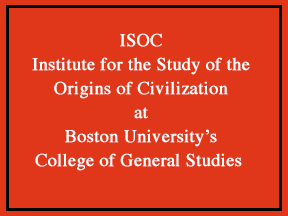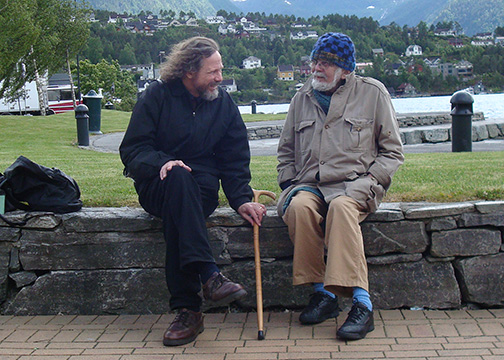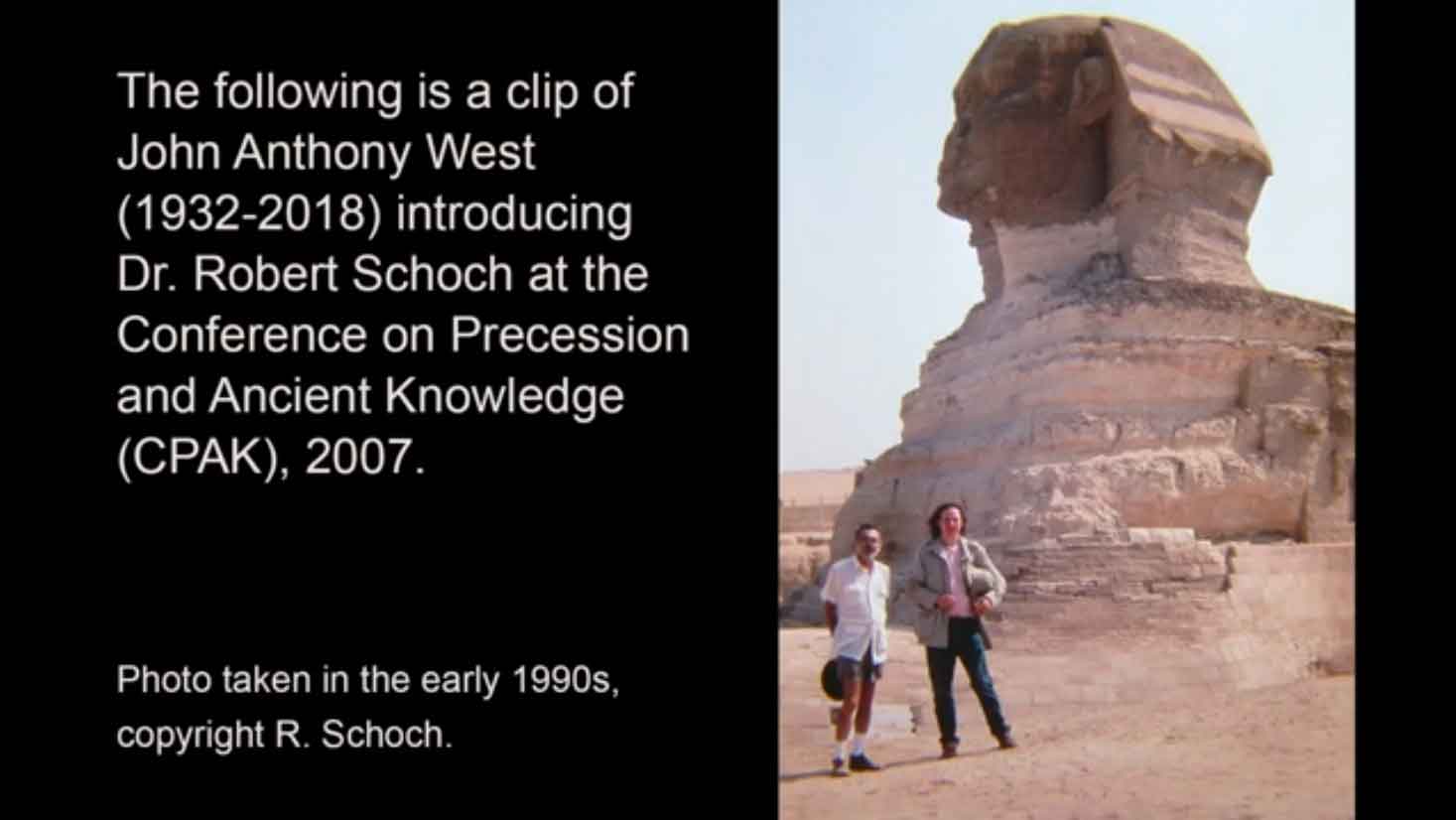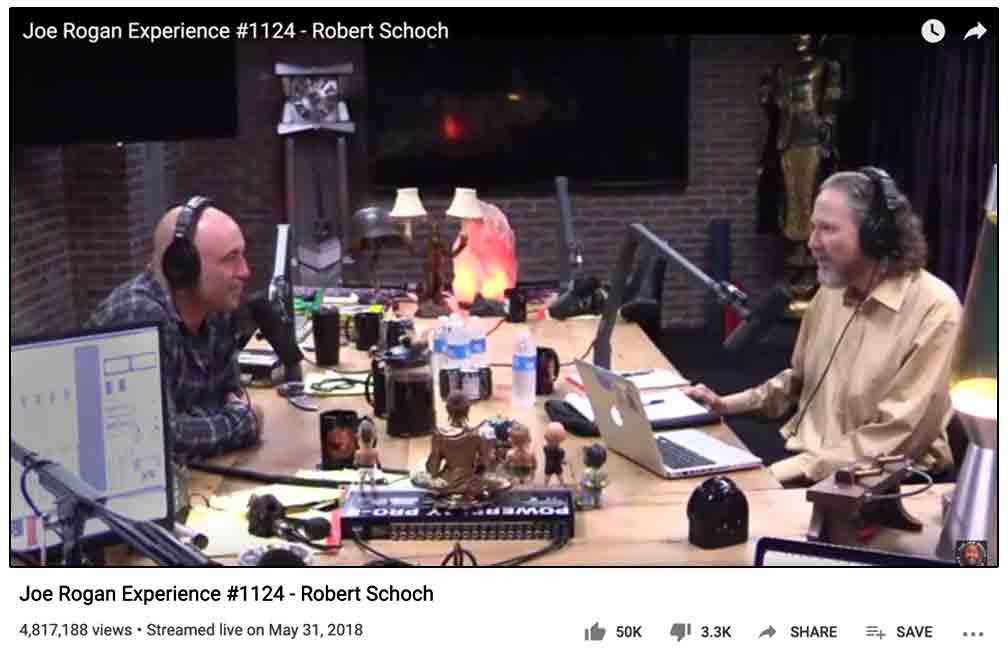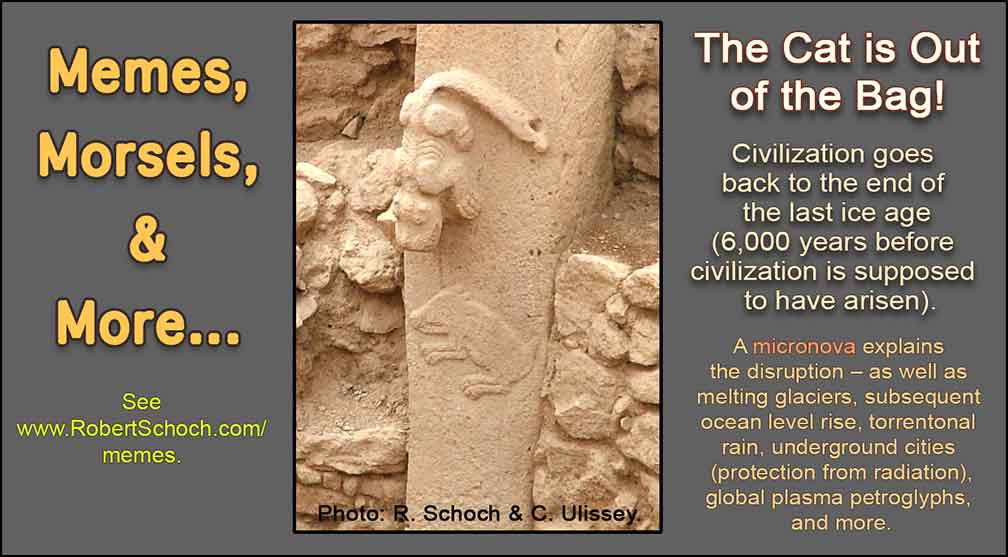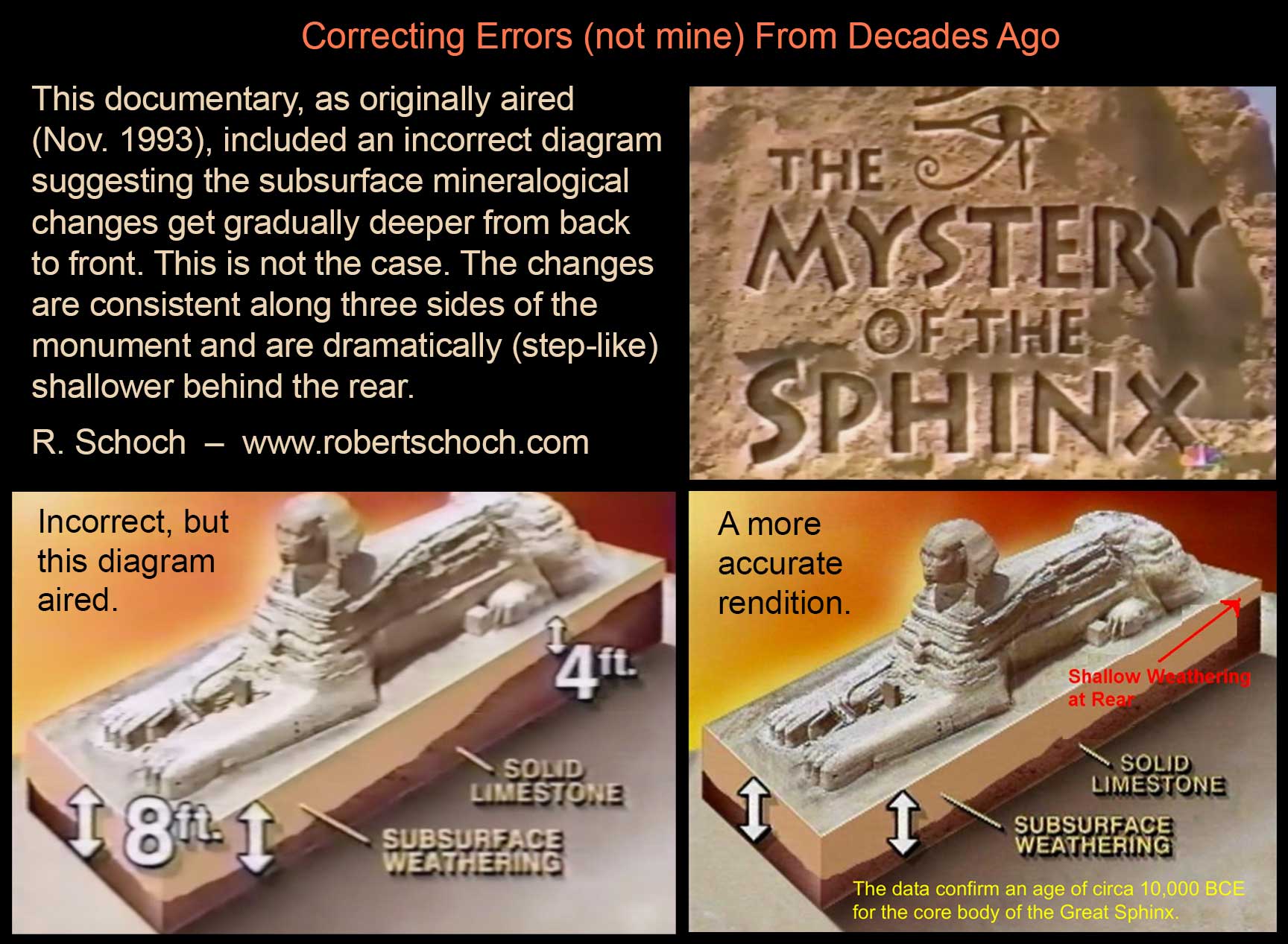
If you right click
this illustration on your computer screen and then select
view image
, you should see an enlarged version of this file. Hopefully this will
help you to get a better understanding of the matter. Look to the rear of the monument in
the bottom right diagram.
The Mystery of the Sphinx
Documentary Corrections
Posted 25 June 2024
The Mystery of the Sphinx
first aired on NBC, 10 November 1993. I (Robert Schoch)
was not shown the film before it aired. When I first viewed it that evening on television,
I was stunned to find that I had been left out of the opening credits, despite being assured
that I would have a place there. Making matters worse, as I watched the show that fateful
evening, I saw a glaring mistake in the diagram used to illustrate our seismic data. This
mistake has caused me untold problems. The subsurface weathering around the Sphinx does not get
gradually deeper from the back to the front, as shown incorrectly in the diagram that aired; rather,
the depth of subsurface weathering is consistent along the sides and front, and it is abruptly
(step-like) much shallower at the very rear of the monument. If the incorrect diagram was accurate,
it would lead to very different conclusions regarding the origins (time depth) of the Great Sphinx.
I show a corrected version in presentations; the data is correct in the original paper that Thomas
Dobecki and I published in 1992 (the year before The Mystery of the Sphinx
aired); and the data
is correct in my subsequent publications. If I had been allowed to view a draft of The Mystery of the
Sphinx
before it aired, this error could have been easily corrected. Unfortunately, I was never given
such an opportunity. And the issues with this film get worse. The original broadcast version of the show
was re-edited and expanded for DVD and Internet sales. I had no knowledge of this beforehand and was never
consulted before or after. All kinds of additional materials were included in the show, some of which I am
very unhappy with and want no association with (such as The Face on Mars
and more). I also want to
point out that I was not paid for my work on the show, and I have not received any royalties or residuals
since (I mention this to clarify any misconceptions). Here is a link to
the program that
originally aired on NBC in 1993. Of all the postings out there
, this is the best one to watch
(in my view), if you are interested. However, please keep in mind my comments above.
For details regarding the seismic work carried out by Dr. Thomas Dobecki and Dr. Robert Schoch in
the early 1990s, please see
Origins of the Sphinx (the 2017 book by Robert Schoch and Robert
Bauval). In this book, the section titled Penetrating Below the Surface: Seismic Techniques Applied
to the Sphinx
(by Robert Schoch, pages 70-86) provides a thorough discussion of the seismic work,
including the pertinent original diagrams and data (first published in 1992 in the journal
Geoarchaeology vol. 7, no. 6) along with references to the earlier technical literature.
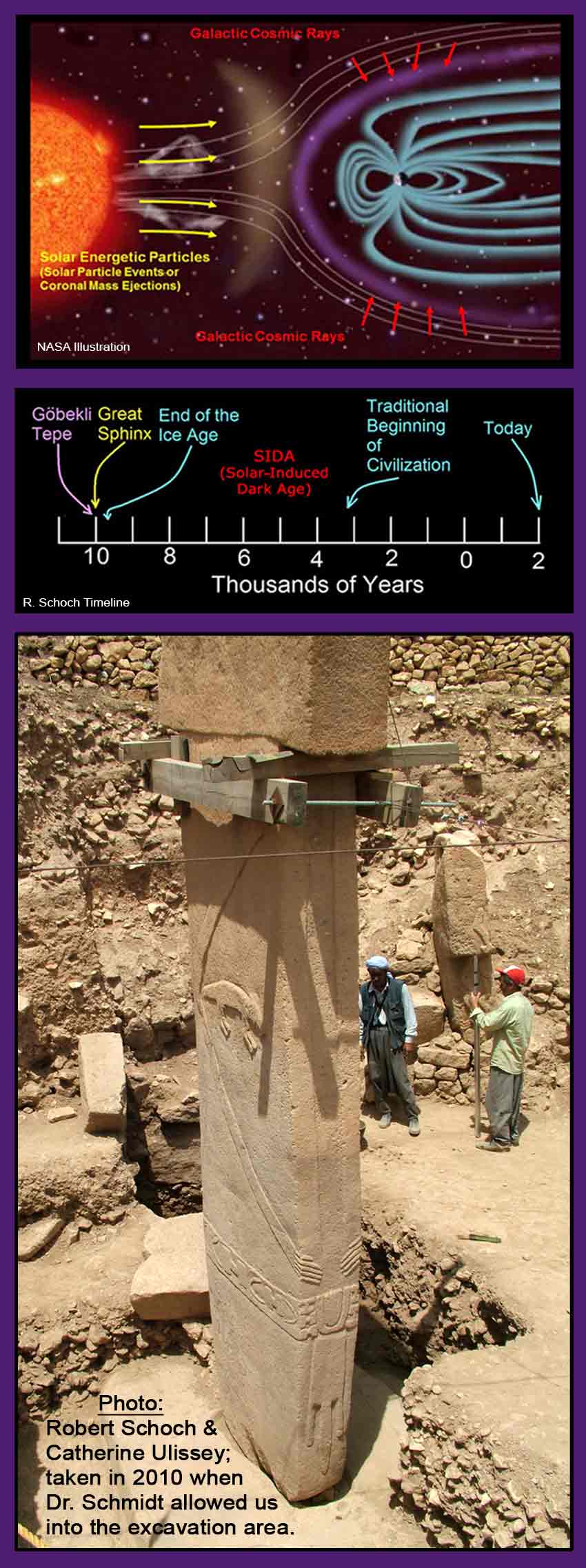
A composite image showing a NASA illustration of solar particles (top), Robert Schoch's timeline for civilization (middle), and a photo of Göbekli Tepe Pillar 18 (bottom).
The Timeline of Civilization:
A few summary points and comments
by Robert Schoch
Posted 10 December 2022
I realize that, unfortunately, sometimes I am lumped or associated with theories that I do not support when it comes to the timeline of civilization and related issues. Here, I wish to clarify (in short summary) some of my own thoughts and conclusions regarding this topic. For further elaboration, see my published works – particularly the revised and expanded edition (2021) of my book Forgotten Civilization: New Discoveries on the Solar-Induced Dark Age.
1) Based on the evidence (see Forgotten Civilization) I have concluded that it was not a comet that ended the last ice age and brought down an earlier cycle of civilization. Rather, it was unusual solar activity at the beginning and the end of the Younger Dryas that was the causative factor. At the beginning of the Younger Dryas (circa 10,900 BCE), a solar outburst melted ice dams, dumping fresh water into the Atlantic, which brought about changes in ocean circulation patterns and initiated a 1200-year cold spell. The Younger Dryas ended circa 9700 BCE (the end of the Younger Dryas marks the end of the last ice age) when a solar outburst dramatically warmed the entire Earth.
2) I would point out that those (at least in the technical literature) who advocate a comet-caused catastrophe date the supposed comet to circa 10,900-10,800 BCE (that is, around the beginning of the Younger Dryas), which is over a millennium earlier than the end of the last ice age (9700 BCE) and the demise of early civilization at that time.
3) There is no solid evidence thus far for a unified global civilization
before
the end of the last ice age, but rather pockets of civilization in Egypt, Turkey, and
elsewhere (and yes, they were probably communicating with each other, but that is not the
same as a unified global civilization).
4) Gatherers and hunters
(which the Göbekli Tepe people, circa 10,000 BCE, may
have been technically since there is no evidence that they had agriculture, although this
remains an open question) may not be so simple and primitive as the phrase sounds and many
modern persons assume. Anthropologists acknowledge complex hunters and gatherers
,
as is well know from modern analogies such as the sophisticated societies of the Pacific
Northwest Coast peoples.
5) Whether or not they had agriculture, the Göbekli Tepe people had true civilization
before the end of the last ice age. Something else, something more profound, I suspect,
was going on than most people want to acknowledge. Many of the comet advocates and
advocates of an alternative historical timeline
continue to think in terms of
outmoded paradigms (for instance, believing that certain materialistic and economic
underpinnings, such as agriculture, are a necessary prerequisite for true civilization)
even as they attempt to push back in time the origins of civilization. Some people in the
field (both status quo academics and so-called alternative historians
) seem
incapable of abandoning preconceived ideologies and worldviews.
6) The concept of survivors
(often interpreted as fair-skinned sophisticates
compared to the Indigenous populations) of an advanced global civilization
traveling the globe and spreading agriculture, domestication, technology, and other
attributes of civilization to local primitive hunter-gatherers after a comet-induced
catastrophe circa 10,900-10,800 BCE is, in my assessment, false. There is no evidence
to unequivocally support this contention and, to reiterate, both the timing and the
causative factor (that is, a comet) are incorrect. People who advocate such a scenario
often confuse dates of sites, compressing or expanding them to suit their own theories,
and interpret equivocal data to match their own biases (such as assuming that various
types of vitrification, minerology, charcoal remains, microspherules, shock lamellae
in minerals, and the like, could only be the result of a comet or similar impactor,
when in fact all of the same sorts of evidence can be more cogently explained in
terms of major solar outbursts). Based on the best evidence, it was solar activity
circa 9700 BCE that brought the last ice age to an end along with the demise of an
early cycle of civilization. Regarding events during succeeding millennia, the
evidence can be, in my assessment, more compellingly interpreted as representing
the localized reemergence of sophisticated cultures and civilization in multiple
areas combined with a certain level of communication between various societies.
7) Based on the evidence, the height of the last cycle of civilization was circa 10,000-9700 BCE (that is, well after the supposed comet catastrophe that some people promote). There was a dark age after 9700 BCE, what I refer to as a Solar-Induced Dark Age (SIDA), that lasted for a good six millennia before civilization reemerged in Egypt, Mesopotamia, and elsewhere during the fourth millennium BCE.
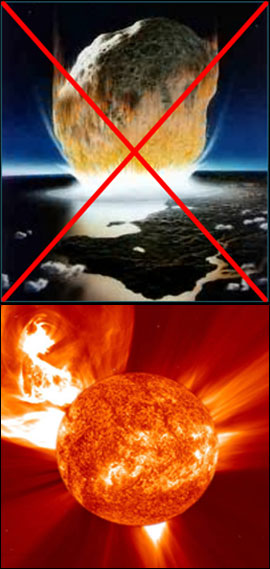
Images courtesy of NASA.
Controversies Regarding the End of the Last Ice Age: Comet/Impactor or Solar Activity?
Extreme climate/temperature swings and Earth changes occurred at the end of the last ice age, in particular at the beginning and the end of the approximately 1200-year period known as the Younger Dryas. Earth had been gradually warming overall, but then there was a cold spell (strongest in the Northern Hemisphere) around 10,900 BCE, initiating the Younger Dryas, which lasted some twelve centuries until the Earth was abruptly snapped out of the last ice age circa 9700 BCE (the end of the Younger Dryas, corresponding to the end of the last ice age).
What caused the beginning and ending of the Younger Dryas has long been a point of
contention, and the debate heated up when a comet theory
or impact hypothesis
was proposed in the 2000s. Various journalists, popularizers, and writers of semi-fiction
and science fiction have picked up on and sensationalized the comet theory
despite
the weakness of the evidence. I have to admit that at first I was favorably disposed
toward such a theory (I write about the effects of comets, meteors, asteroids, and
other impactors in some of my earlier books); however, after carefully analyzing the
purported evidence put forward to support such ideas, I am not convinced. I believe
that solar activity can better explain the major changes at the beginning and end
of the Younger Dryas. For the interested reader, I offer a few links below that give
some background regarding this controversy.
In a nutshell, I believe that increased solar activity at the onset of the Younger Dryas
(circa 10,900 BCE) melted ice dams, causing a massive glacial flood. This allowed large amounts
of fresh water from the Arctic to flow south, disrupting ocean circulation patterns,
resulting in global cooling and the planet being thrown back into its ice age. This
cooling lasted approximately 1200 years. Then, circa 9700 BCE, data indicates that the
Sun again erupted ferociously. This warming marks the rapid ending of the Younger Dryas
and the end of Earth’s last ice age. Incidentally, a solar event on the order of a
micronova
could explain impactor
events on Earth as well, as the Sun would
eject not just plasma, but also dust and debris.
For the interested reader, I present myriad lines of evidence supporting the above comments in my book Forgotten Civilization. I do recommend the 2nd (revised and expanded) edition, released in March of 2021. This 2nd edition bears the new subtitle, New Discoveries on the Solar-Induced Dark Age, referring to the 6,000-year period between the end of the last ice age and the re-emergence of civilization circa 3500 BCE.
Solar events bring together otherwise seemingly disparate mysteries regarding the ancient world, such as underground shelters found worldwide (needed for protection from radiation), the extinction of many large mammals (they could not be sheltered within rock with the few human populations that survived), the rise in ocean levels (from the melting of vast glaciers), and global plasma petroglyphs as first identified by physicist Dr. A. Peratt (indicating that ancient people witnessed and recorded a massive solar event). Searing solar plasma striking vast bodies of water pumped moisture into the atmosphere, which poured down as torrential and protracted rain, explaining the great rains upon the Great Sphinx in prehistory. Etc.
In 2015 I wrote a short article for Atlantis Rising regarding this subject. Unfortunately, the magazine has gone out of business. However, an expanded version appears as Appendix 9 of Origins of the Sphinx.
The following two links give some background on the controversies regarding the comet theory
:
https://psmag.com/environment/comet-claim-comes-crashing-to-earth-31180
and https://www.sciencenews.org/article/younger-dryas-comet-impact-cold-snap.
The following article discusses the evidence indicating that it was not a comet, but rather a massive glacial flood (which, I would point out, could have been caused by solar activity melting ice dams and glaciers) that changed ocean circulation patterns in the Atlantic, thus initiating the Younger Dryas cooling: https://www.washingtonpost.com/energy-environment/2018/07/11/scientists-may-have-solved-huge-riddle-earths-climate-past-it-doesnt-bode-well-future/?noredirect=on&utm_term=.6f7d7c278f5c.
Regarding the Hiawatha Crater in northwest Greenland: Reading
the actual journal article (from Nov. 2018),
and looking at the details of the stratigraphy, it does
not appear to me to date to the Younger Dryas. As the authors write: The sum of these tentative age
constraints suggests that the Hiawatha impact crater formed during the Pleistocene, as this age
is most consistent with inferences from presently available data.
(p. 9) The Pleistocene dates
from 2.6 million years ago to 11,700 years ago. Impactors collide with Earth, no doubt, and this
is evidence of such. But it has yet to be dated to the Younger Dryas, as so many apparently wish
it to be.
And here is the latest (as of March 2022), on the Hiawatha Crater, now dated to a time period far removed from the Younger Dryas, as I suspected; indeed, the data indicates it dates to over 50 million years ago.

Awarded an Honorary Professorship
On 28 November 2014 I was awarded, in recognition of my ongoing research into ancient civilizations, the title of Honorary Professor at the Nikola Vaptsarov Naval Academy in Varna, Bulgaria.
Boston University's New Institute for the Study of the Origins of Civilization (ISOC)!
I am so pleased to announce that the College of General Studies at Boston University, where I have been a full-time faculty member for over thirty years, has established the Institute for the Study of the Origins of Civilization (ISOC) - in part inspired by my research into the antiquity of civilization (now supported by sites around the world, most notably at the breathtaking Göbekli Tepe in Turkey dated to the end of the last Ice Age). I am pleased to add that I have been appointed the institute's first director.
John Anthony West (1932 – 2018):
A Tribute to My Friend
Even though he had been fighting a battle with cancer for over a year, I was not fully prepared to learn the news that my dear friend John Anthony West (JAW) had parted from this world. There are no words to express the profound sadness and loss that I feel. One of the themes of his research, apart from our work together on the Great Sphinx, was dying and death from the perspective of the ancient Egyptians. I find solace in pondering some of JAW’s own words on the subject. Please click here to read more. And wherever he is now, I wish my friend a blessed journey. I will miss him greatly.
John Anthony West Introducing Robert Schoch at CPAK 2007
This short (4.5 minute) video, posted to ORACUL's YouTube page, offers a humorous accounting by John Anthony West of how he and I became acquainted and came to work together. It is one of Katie's favorite clips. Incidentally, it was also at CPAK 2007 that Katie and I met.
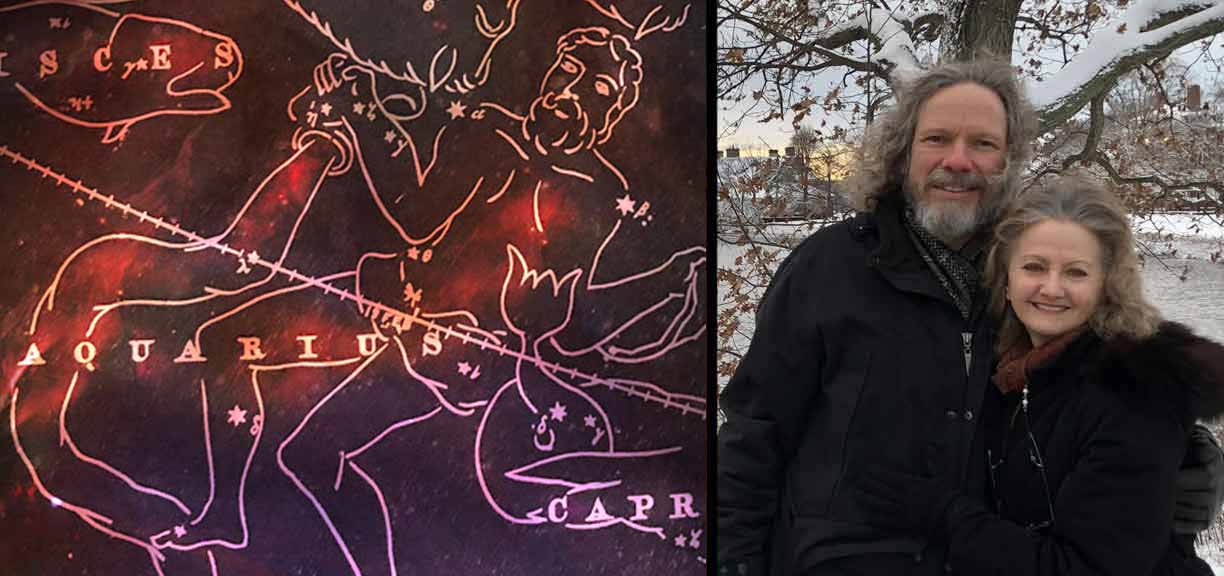
Left to right: Aquarius (one rendering of him derived from images in the public domain),
Robert Schoch, and Catherine (Katie
) Ulissey.
Katie's article regarding Aquarius and the Cosmic Currents
Katie's first published article, which I am proud to share with you, is titled
Does the Water Bearer Bring Forth a River of Fire?
. It was originally written
for the National Council for Geocosmic Research's (NCGR's) eNews publication,
the April 14th, 2020, edition. Katie is a student of astrology (see her page
on this website for more about her). My research, and the work she and I are pursuing together,
led her to question why Aquarius, an astrological Air sign, is also called the Water Bearer
.
Is the term a warning from the Ancients? Did they possess an understanding of the cosmos that
we are only now beginning to reclaim? I lent my name to the initial publishing; however, the
writing is entirely Katie's.
Click here to read more (and be sure to not miss her three
important postscripts).
Video trailer for a master class Robert Schoch conducted at Boston University in 2015
My Research in a Nutshell
In 2015 I was asked by Boston University to give a master class of my research to a select group of its alumni/alumnae. This video trailer was made by the University for the event. Compressed down to less than two minutes, it encompasses highlights of my research over a quarter century, from my initial work re-dating the Great Sphinx (based on the geological evidence of water erosion on the monument and on the walls of its enclosure, seismic analyses, and much more) to my findings regarding a major solar outburst as a cause of the end of our last ice age and the decimation of the high civilizations of the time. More detail regarding this research can be found in my book, Forgotten Civilization: New Discoveries on the Solar-Induced Dark Age.
For those who might like to share this trailer with others, as an introduction to my research, here is the link to use: https://www.robertschoch.com/misc_news.html#bu_master_class
My Interview with Joe Rogan
In May of 2018, I was interviewed by Joe Rogan for his very popular podcast series. This interview was available on YouTube for many years, and as of October 2020 (the last time Katie and I noticed it posted there), it had been watched by close to 5 million people (with, according to Mr. Rogan, many more millions listening via audio-only downloads). I thank Mr. Rogan for introducing me and my research to his broad and enthusiastic audience. Last I learned, Mr. Rogan moved his programming to Spotify. The interview can still be viewed there, but (as I understand it) one must create an account first.
Memes, Morsels, and More:
In an effort to draw interested people more closely to our work, we spent a little time in recent years making some memes, which we posted to our various social media pages. (We are on Facebook and Twitter primarily; we have Instagram accounts but regrettably find little time to engage there.) For those who may have missed them, please click the following link (or the adjacent photo) to go to the Memes page of this website.

